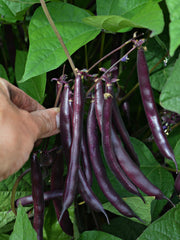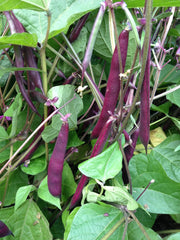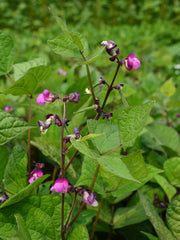Bean, Bush Snap, 'Blooming Prairie'
(P. vulgaris) We generally regard purple beans as we do purple bell peppers or purple kale, which is, quite nice to look at, but nothing that tastes remotely as good as it looks (and often even that phrasing is too polite). Enter Blooming Prairie, passed along to us from Dan Jason of Salt Spring Seeds in BC. Named after a town in Minnesota, Blooming Prairie hangs heavy with glossy purple, slender, straight, and crisp pods. The flavor is full and decidedly old-school "beany" in the best way, the texture crisp and refreshing. This one may change your opinion about purple beans; it did ours. Sometimes, these like to think they are pole beans! If you give them the support, they may vine up a couple of feet. Don't give them any ideas! As a side note, the dry beans are simply gorgeous!
55-60 days. UO
Packet: 1/2oz.(~50 seeds)
Availability: In stock
Growing Info
SOWING:
Direct seed after the last frost date when the soil has warmed.
Note: Beans prefer well-drained, warm soil.
PLANTING DEPTH:
1"
SPACING:
3-5" between plants with 12-24" between rows*
*Pole beans require 5+' between rows.
EMERGENCE:
5-10 days @ soil temp 65-90F
LIGHT:
Full sun to part shade
FERTILITY:
Light to Moderate. Beans can produce their own usable nitrogen from atmospheric nitrogen through a symbiotic relationship with bacteria that colonize specialized nodules in their roots. Too much soil fertility can cause excessive vegetative growth at the expense of pod set and maturity.
Beans prefer well-drained warm soil with a pH between 6.0-7.0.
ADDITIONAL NOTES:
Beans prefer warm soils and may rot at lower temperatures. This is particularly true for white-seeded varieties. You love beans. Patience.
It can be quite beneficial to mix bean seeds with commercially available bacterial "inoculants" to encourage the beneficial symbiotic relationship in the growing plant's root nodules, especially if growing on ground that hasn't been planted with beans before. This can increase yields and improve plant health.
Avoid picking/weeding beans when the plants are wet. This will help prevent the spread of disease.
Provide a trellis for pole beans.
White-seeded varieties are more susceptible to rot when seeded in cool, wet, early-season conditions.
Sow Snap Beans every few weeks for continued harvests.
Harvest dry beans when the pods are brown and dry.






